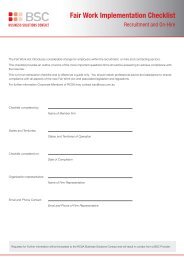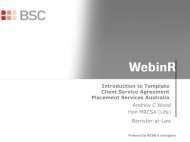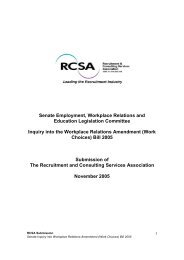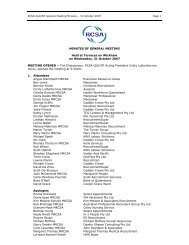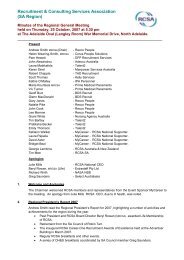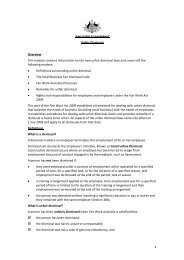June 2012.pdf - RCSA
June 2012.pdf - RCSA
June 2012.pdf - RCSA
You also want an ePaper? Increase the reach of your titles
YUMPU automatically turns print PDFs into web optimized ePapers that Google loves.
focus: RECRUITMENT AT THE SPEED OF TOMORROW<br />
Of course, there needs to be a baseline for<br />
skills – but sometimes it’s actually better for<br />
employers to develop an individual’s skills to<br />
meet the organisation’s own practices and<br />
standards, as it avoids them having to “unlearn”<br />
old habits.<br />
However, understanding which skills are<br />
transferable for a particular role isn’t always<br />
obvious – this is where you need to have<br />
your antenna out, in order to get to the heart<br />
of the role and what it requires. It’s likely that<br />
the clients know what they need; it just may<br />
not be apparent to them yet.<br />
If you’re leading a team, you need to embed<br />
this process and thinking in all of your team<br />
members too, and make it both normal and<br />
acceptable to spend time on the brief.<br />
However, the common objection to this<br />
approach is time – or a lack of it. With sales<br />
targets and quotas to fill, how do you find<br />
time to have long conversations with clients<br />
The answer is that investing time at the<br />
start of the process saves time and tears later<br />
on. Getting the brief right, first time, avoids<br />
the back-and-forth that happens when<br />
candidates aren’t right, because expectations<br />
are unclear and wires are crossed. It also<br />
takes a lot of frustration out of the process<br />
– for both you and the client!<br />
Crafting and influencing the brief also means<br />
you’ll spend less time looking for “hen’s teeth”<br />
– that elusive perfect-fit candidate – because<br />
you have set expectations at the outset and<br />
have scope to present the seventy per cent fit.<br />
This stage of the relationship is also an<br />
opportunity to provide input on the client’s<br />
selection process overall, and can be a real<br />
value-add to the client. If, for instance, you<br />
think that a four-stage interview process is<br />
going to undermine the client’s best efforts<br />
to woo your hard-to-find candidate, then<br />
you need to raise it.<br />
Work with them to ensure the onboarding<br />
process is sound as well: the best employers<br />
have a structured “First 90 Days” plan for<br />
employees, because that’s when people<br />
often make their decisions about an employer.<br />
The candidate is the key<br />
To make this approach work, you also need<br />
to work with your candidates to bring them<br />
on the journey. The individuals who<br />
undertake our outplacement programs get<br />
an opportunity to step back and see their<br />
strengths and achievements. They don’t<br />
end up with a shopping list of roles and<br />
responsibilities, but a considered summary<br />
of their professional profile.<br />
We encourage candidates to design their<br />
CV afresh for every job application, creating<br />
a 1-2 page career summary targeted at the<br />
opportunity. The goal is to have an employer<br />
say, “this person looks interesting” and start a<br />
conversation with them, rather than focusing<br />
on where their CV differs from the job brief.<br />
Making change stick<br />
Changing the way we work is not always<br />
easy. If you want to move away from the<br />
“order-taking” mindset into “trusted adviser”<br />
territory, you may need to revisit the<br />
fundamentals of change management.<br />
• Be clear on why you (or your team)<br />
should change. What are the benefits in:<br />
increased fill rates, more client satisfaction,<br />
less stress<br />
• Find someone who does it well, and<br />
use them as a role model<br />
• Keep the issue top of mind and on the<br />
agenda. Are there some successes you<br />
can celebrate at team meetings, or<br />
obstacles you can workshop<br />
• Survey clients specifically on this to see<br />
if it’s working and being embedded<br />
• Measure and reward outcomes related to it<br />
– for example, the success of applicants in<br />
their roles after six months, or the<br />
longevity of client relationships.<br />
Ultimately, everyone wants to deliver great<br />
service to clients. If that means drilling down<br />
to what the client genuinely needs, rather than<br />
what they think they need, then changing the<br />
brief may just change the game altogether.<br />
Bridget Beattie is the Regional<br />
General Manager for Right<br />
Management in India, Australia<br />
and New Zealand, providing<br />
talent management and career<br />
management consulting to<br />
clients across a broad range<br />
of sectors.<br />
JUNE 2012 13



